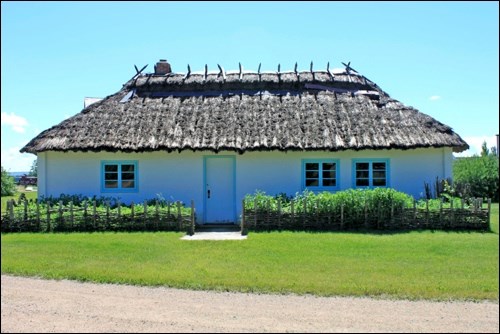The foundations for the Ukrainian House at the WDM Village were laid in 1967 with Alex Balych from the Canadian Ukrainian Association in charge of building this tribute to the Ukrainian pioneers of Saskatchewan.
Constructed from cinder blocks with a clay and plaster whitewashed covering, the house has a thatched roof made up of 12 layers of thatch that overlap like shingles. The roof is held up by large log rafters, and is topped off with a row of crossed roof-riders. It takes 3,000 bundles of rye harvested in the blue haze stage (where the seeds have not yet developed that would attract birds and rodents which would damage the stalks), grown to about five feet, to fully cover the roof. The rye that was used to thatch the house in 1999 was actually grown at the WDM. It replaced a leaking roof of slough-hay that had been put on in 1983. Once harvested it is stooked and left to stand for 10 days before the process of splitting, combing and tying of the bundles begins.
Inside the house there are two rooms, a kitchen with a working bread oven and a sitting room-bedroom combination with original furnishings and textiles. The tablecloth was hand stitched by Mary Kindel from Meadow Lake and was over 100 years old in 1969 when it was donated to the WDM Ukrainian House by the owner. There are also traditional Ukrainian pillowslip covers and a bedspread that took eight years to complete, such is the intricacy of the embroidery on them. The pillows are in graduating sizes, with the largest pillows and bedspread normally being used only on Sundays and festive occasions. This information was gleaned from some newspaper cuttings found in our scrapbooks and has not yet been substantiated.
Pioneera in 1969 saw the Ukrainian home providing borscht and fresh baked bread from the oven. The Canadian Ukrainian Association held their first venture during Those Were The Days in July 1969 when a meal was served to 500 people, organized by Mrs. P. Malitski.
The house was completed and opened with much ceremony, in Ukrainian and English, on June 27, 1971, by Mike Balych Sr. and Mr. Torchuk, with the opening ribbon being held by the reigning king and queen of the Greek Orthodox and Ukrainian Catholic Youth organizations. The church was also opened on the same day and a monument to the Ukrainian pioneers was unveiled and blessed by the Reverend S. Zuzak, who conducted the first service in the Ukrainian Church. Traditional songs were sung and there were Ukrainian dancers to entertain the crowd. Invitations were sent to Ukrainian residents of 80 years of age and over, as the house was opened 80 years after the first Ukrainians homesteaded in Canada. Tribute was paid to these early settlers and all they had accomplished.
During its time on the WDM site, the house has received many visitors, but three especially are of note, both to the museum and also to the Ukrainian community. The first was in 1970 and his name was Joseph Lesawyer. He was, at that time, the supreme president of the Ukrainian National Association in America and was on a visit to the Battlefords. Lesawyer was also president of the Ukrainian Professional Society of North America and executive director of the Shevchenko Memorial Committee of America. During his tenure was responsible for arranging for the erection of a monument to Taras Shevchenko in Washington in 1964.
Lesawyer was accompanied by Canadian Senator Paul Yuzyk, who was known as the father of multiculturalism after a speech in which he criticized Lester Pearson regarding the Royal Commission on Bilinguilism and Biculturalism. Yuzyk said this ignored the fact that Canada was, in fact, a multicultural society, an ideal upheld later by Pierre Trudeau. Senator Yuzyk met with Trudeau in Winnipeg in 1971 after Trudeau announced the policy of multiculturalism at the Ukrainian Canadian Congress in October 1971.
A third visitor was Stephen Worobetz, who was the 13th lieutenant governor of Saskatchewan. Originally from Krydo, he was the first lieutenant governor of Ukrainian origin. While servicing with Princess Patricia’s Light Infantry as a medical officer during the Second World War, he was awarded the military cross in Italy for courage under fire.
So the house has seen many visitors. It has also experienced a lot of weather, which is now sadly taking its toll on the thatched roof, along with vermin infestation. Because thatching is a rare occupation, it has proved difficult to even repair the roof and the integrity of the building and its contents are now in jeopardy. So if anyone reading this article has any knowledge of the ancient art of thatching, we would welcome the assistance in restoring the crown of this property to its former glory.




